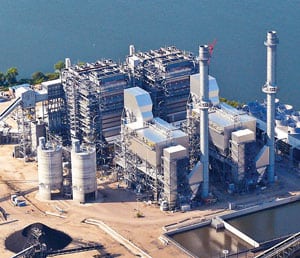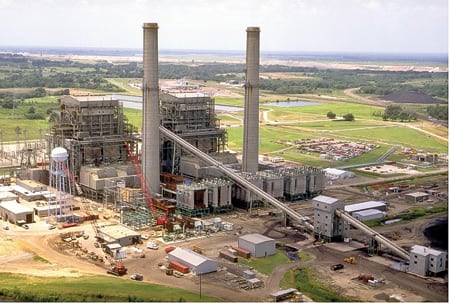Vistra Closing Two More Giant Uneconomic Coal Plants in Texas
Vistra Energy moved to halt a financial hemorrhage stemming from unprofitable conditions in the Electric Reliability Council of Texas (ERCOT), announcing plans to shutter two more coal-fired power plants—the 1.1-GW Sandow Power Plant (which includes a 2009-built unit) and the 1.2-GW Big Brown plant—in early 2018.
The company’s decision made public on October 13 comes on the heels of an announcement last week by Vistra Energy subsidiary Luminant to shutter its 1.9-GW coal-fired Monticello plant in Titus County.
Vistra Energy said the coal plant closures are necessary because they are “economically challenged in the competitive ERCOT market.” Specifically, it said, “Sustained low wholesale power prices, an oversupplied renewable generation market, and low natural gas prices, along with other factors, have contributed to this decision.”
Terminating Years of Service
“This announcement is a difficult one to make,” said Vistra Energy President and CEO Curt Morgan. “It is never easy to announce an action that has a significant impact on our people. Though the long-term economic viability of these plants has been in question for some time, our year-long analysis indicates this announcement is now necessary.”
The Sandow plant in Bastrop County, central Texas, has two units, one built in 1981, and the other in 2009. The Big Brown plant in Freestone County also has two units that were brought online between 1971 and 1972. Sandow and Big Brown are fired with lignite, though Big Brown supplements with Powder River Basin coal.

Vistra also said it entered into a contract agreement with Alcoa to terminate a long-standing power and mining agreement for the Sandow site. Alcoa will make a one-time payment to Luminant. The Three Oaks Mine in Bastrop County, which supports Sandow, will also close.
“The settlement follows a decrease in wholesale power prices in ERCOT and the prior curtailment of Alcoa’s smelter operation next to Sandow,” the company explained. “The contract has helped shield Sandow from significant exposure to the downturn in the wholesale power market; however, the standalone economics of the Sandow complex no longer support continued investment in the site in this low wholesale power price environment.”
Luminant has filed a 90-day notice of suspension for the Sandow plant, which has 450 employees. If ERCOT determines it isn’t needed for reliability, the plant will cease operations on January 11, 2018.
At Big Brown, which is manned by 200 employees, despite “tremendous operational adjustments to remain viable given the challenging market conditions,” the plant just didn’t generate enough revenue to keep it economically viable, Luminant said. “The company will explore a sales process for the site during the ERCOT notification period,” it said.

The Turlington Mine, which supplies Big Brown, has already been scheduled to close by the end of this year. If ERCOT determines Big Brown isn’t needed for reliability, it will close on February 12, 2018.
The plant closures will cost Vistra about $70 million to $90 million in the fourth quarter of 2017 related to employee-related severance costs and non-cash charges for writing off materials inventory and a contract intangible asset associated with Big Brown.
The Tip of the Coal, Nuclear Iceberg in ERCOT
As POWER reported this week in an in-depth analysis on market troubles in ERCOT, economic pressure is clearly mounting on ERCOT’s existing coal and nuclear units because their non-shortage prices—the vast majority of net revenues they earn—have been “substantially affected by prevailing natural gas prices.”
Over the past two years, wholesale power prices have fallen drastically in ERCOT—the entity that manages 90% of Texas’ electric load, three-quarters of which is in the competitive market. In 2014, for example, while prices varied by zone across the market owing to congestion costs, the average annual real-time energy market price hovered at $40.64/MWh. In 2016, that average fell to $24.62/MWh—an all-time record low in ERCOT. In the first eight months of 2017, meanwhile, prices averaged $28.64/MWh.
On October 12, ERCOT spokesperson Robbie Searcy told POWER that from a systemwide resource adequacy perspective, based on current information from market participants, ERCOT expects to have sufficient generation capacity available to serve expected demand over the next several years.
“We also have a number of tools to maintain overall system reliability in a wide range of scenarios,” she said. “Investment and interest in new generation continues in the ERCOT market.”
She confirmed that grid entity “announces and accounts for retirement notices as they are received,” because generators make decisions about the future of their plants based on factors unique to their companies.
But ERCOT isn’t alarmed by the potential mass retirements. “The ERCOT market has seen cycles of retirements and new investments in the past, so these types of shifts are not without precedent,” she said.
Asked about ERCOT’s current market outlook for coal and nuclear generation, Searcy pointed out that the ERCOT market “provides a diverse portfolio of resources to support reliability.”
However, she noted, all new generation in the Texas pipeline is natural gas, solar, or wind. “As of Sept. 30, more than 21,000 MW of potential utility-scale solar generation was under study, along with more than 20,000 MW of potential wind generation and about 4,000 MW of potential gas-fired generation resources. This is in addition to existing interconnection agreements for 10,511 MW of new gas-fired generation, 2,050 MW of new solar and 8,655 MW of new wind,” she said.
—Sonal Patel is a POWER associate editor (@sonalcpatel, @POWERmagazine)